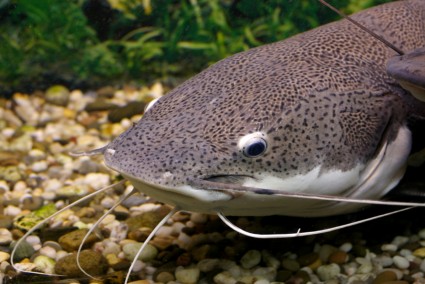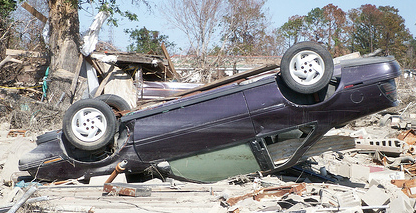In Checkout Line, Lou Bendrick cooks up answers to reader questions about how to green their food choices and other diet-related quandaries. Lettuce know what food worries keep you up at night.
————-
 What’s up, cat?Dear Lou,
What’s up, cat?Dear Lou,
My wife and I enjoy fish and like to eat a variety of types of fish. Living in Minnesota we have access to locally caught walleye but have to be careful not to eat too much because of mercury content in MN lakes. I’ve been a big fan of catfish (bottom feeders) and am curious as to the pros and cons of farm-raised catfish. Are we talking similar issues with farm-raised catfish as Tom Philpott’s recent essay re: farm-raised salmon?
We’d like to know more!
Best,
Glenn D. Geissinger
Dear Glenn,
Dang! I hear walleye are delicious. According to Minnesota’s fish advisory you can eat one walleye meal a week, but if your wife is pregnant she’s out of luck. On the upside, local crappie is less restricted, but, wow, talk about the need for a serious re-naming campaign.
I’m also a big fan of catfish, especially in light of some research. But-and this is a big but-you have to be savvy before you reach for that Po’ Boy.
So let’s get to the pros and cons, bad news first:
Cons:
Most of the catfish eaten in the United States is imported, and unless you specifically ask for “U.S. Farm-Raised Catfish,” or see the official seal, you might be getting Asian-farmed catfish. FYI on the name game: Vietnamese pangasius (tra or basa), is a different species of catfish than the kind grown here (channel catfish), and cannot be called catfish in the American market. Because the Chinese now farm the same variety of catfish as we do, it will be labeled catfish. So, look for “Product of China” on fish labels–and avoid it! This is potentially very bad stuff. Beware also of any white fish that cannot be linked to a source. Beware of the generic term “fish.”
• Many of the problems with farmed salmon identified in Tom’s post apply to catfish farmed in Asia. Catfish from there is often contaminated with carcinogens such as malachite green, illegal antibiotics or salmonella In Alabama, state scientists have found banned antibiotics in catfish from China. The FDA is responsible for ensuring the safety of foreign-farmed fish. It has been notoriously lax at doing so. (Luckily, American catfish are sustainably farmed. I’ll get to that soon.)
• According to the catfish wiki, catfish can’t be kosher because the fish lack scales. This would pose a problem for observant Jews.
• The high-protein feed (made from soy, corn and rice) that farmed catfish eat is not organic.
• Some people find the taste boring, occasionally muddy, or think catfish is merely a vehicle for batter and hot sauce.
• Because farm-raised catfish eat vegetarian feed, they are not as high in Omega-3 fatty acids as cold-water fatty fish, such as sardines.
• All-American catfish may not be easy to find. As many as one-third of U.S. catfish farmers recently went out of business because of the high cost of soy and corn. This may one reason that two of my favorite markets didn’t carry catfish at all. It could also be a perceived stigma: Many diners turn their nose up at lowly bottom feeders, and catfish has the reputation for being the poor man’s fish. One of my friends who is a fishmonger at a high-end grocery explained, “People here just don’t want it. It has pretty much been replaced by tilapia.”
Pros:
Other folks praise its flavor as mild or even sweet. I recently broiled some U.S. farm-raised fillets with a little butter and served them with a simple squeeze of lime. They were terrific and so mild that my friend Kim described them chicken-like. “So un-fishy,” she said with disbelief. “My kids would eat this.”
• At Price Chopper I paid $5.99 per pound for the aforementioned fillets; farmed salmon was $9.99 per pound. Evidently pesticides, sea lice and antibiotics cost extra.
• Safety standards for U.S.-grown catfish are high and catfish farmers are pushing for ever more rigorous regulation. By contrast, there are currently no international safety standards for fish, hence the nasty stuff sometimes found in Asian imports. And few imports are inspected. (See my admonition above to read the label!)
• It’s American, goddamnit. (I’m in a protectionist mood these days.) In addition to racking up fewer food miles, eating this native fish keeps American farmers in business.
• Unlike farmed salmon, catfish farmed here are freshwater fish and therefore raised in self-contained inland ponds, which means they are not very likely to escape into the sea and overtake other fish populations. These self contained pens also pose little risk to the surrounding environment (unlike open-ocean pens used for salmon). This is why green groups such as the National Audubon Society, Monterey Bay Aquarium, and Environmental Defense endorse U.S. catfish as a safe environmental choice.
• Unlike salmon, catfish are vegetarians and fed vegetarian feed, as opposed to the wild-caught fish that salmon are fed.
• You can eat it every day! Because American catfish are not raised in coastal environments and kept in clean aerated pens that use well water and fed vegetarian feed they are very low in contaminants such as mercury. (Vietnamese catfish on the other hand are farmed using river water that may contain all manner of pollutants, including human excrement.) Antibiotics are seldom issued to US Farm-Raised catfish and hormones are never used.
• Eating bottom feeders is cool. Eating lower on the food chain gives our depleted fish stocks a chance to recover and reduces our chances of ingesting heavy metals and poisons often found in many predatory fish. It’s also worth noting that stigmas can be reversed: At one point in our nation’s history lobster was considered too déclassé to eat; people fed it to pigs (man, can you imagine how awesome that bacon must have tasted?). U.S. farm-raised premium catfish fillets (which are thicker) may get an anti-stigma boost through a new name: Look for it in 2010 as “Delacata.” (Hey, it worked for Orange Roughy, which used to be Slime Head. Take notes, crappie!)
Bottom line: Pass the hot sauce and enjoy U.S. farm-raised catfish whenever you can get it. If you can’t find it, ask your fishmonger or grocery store to order it. Because you mentioned that you like to eat a variety of fish, here’s two of my favorite tools that make choosing sustainable and healthy seafood easier: A seafood watch list that can be tucked into your wallet or downloaded to your cell phone and an online mercury calculator.
Your devoted food columnist and lover of all things with gills,
Lou



